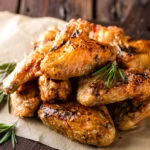If you have a love of cooking, you’ve likely run across a paring knife during your time in the kitchen. There are different variations of the paring knife, including the classic, regular paring knife (which looks like a mini chef’s knife), the bird’s beak paring knife, the serrated paring knife, and a sheepsfoot paring knife (which looks similar to a santoku knife).
These knives are characterized by their small size, thin blade, and pointed tip. All of them have different uses, and all of them are great at what they do! These knives are small but mighty and are often the go-to tool for professional chefs doing detailed work in kitchens.
But what exactly can these knives do? In this article, we’re going to explore all the cooking tasks these knives can help you excel in, from basic prep work to intricate, detailed cutting. Plus, we’ll give you the steps you need to accomplish some of these tasks yourself.
What Does a Paring Knife Do?
Let’s answer everyone’s most burning question: What exactly can a paring knife do? Well, this kitchen knife is good at just about anything. While they may not be big enough to cut through meat and bones (a task better suited for a carving knife), they are perfectly adept at other kinds of kitchen work.
Paring knives are great for basic kitchen tasks. Their knife blade is great if you need to mince any herbs and spices, core tomatoes, cut out the insides of peppers, or even chopping up basic vegetables like zucchini, onions, or asparagus. They’re also great for cutting up fruits, from berries to bananas, making thin slices. They’re also a great replacement for a vegetable peeler, thanks to the sharp edge on their stainless steel blade.
If you like to use every bit of a fruit or vegetable, the paring knife may well be your new best friend! These knives are great for slicing away small imperfections and bruising on food, which is great for those trying to eliminate food waste in the kitchen.
Their small size also makes them amazing tools for small, detailed work in a kitchen. Have you ever seen a fruit platter or a charcuterie board with beautiful, intricately cut pieces of fruit? It was likely the work of a paring knife, alongside other tools, that made something so beautiful!
These knives are perfect for any small, precise cuts you may want to make in the kitchen. This makes them a great replacement for different knives you may not have in a basic kitchen setup, like a cheese knife, steak knife, or tomato knife. If you’re looking for a small knife, we suggest a paring knife for the task.
Things to Do With a Paring Knife
Now that we know more about what a paring knife is capable of, let’s learn more about some of the things it’s best at. If you have a carbon steel paring knife at home, you should definitely try out all of the techniques we’re listing below, to get the most out of this kitchen tool.
Peeling Fruits and Vegetables
A paring knife is a great tool for any basic fruit and vegetable peeling! If you want to peel with a paring knife, we recommend not using one with a serrated blade. Instead, use a classic sharp paring knife.
Step 1: Place the Knife
To peel fruits or vegetables with a paring knife, hold your fruit in one hand, and the knife in the other. Then, set the knife blade on the skin of the fruit, at a slight angle.
Step 2: Slowly Peel
Slowly make a small cut to get just under the skin, then, drag the blade towards yourself to remove the skin. Repeat the process until all the skin is gone!
Coring Tomatoes
Removing the core of a tomato is a breeze! For best results, you’ll want a utility knife with a slightly curved blade and sharp tip. A serrated knife can be used here!
Step 1: Place the Knife
To core a tomato, take the tip of your paring knife, and insert it beside the core, pushing down an inch.
Step 2: Cut and Remove
Then, you can slowly cut around the core, with the knife at a slight angle. The core should easily be removed after you make your way around.
De-veining Shrimp
De-veining shrimp with a utility knife isn’t a problem! While this task can be messy, with the right level of precision, it should be a breeze. Here, avoid using a paring knife with a rounded tip or serrated edge. The classic, chef’s knife-looking paring knife or bird’s beak paring knife, is best here.
Step 1: Place Your Shrimp
To get started, first take your raw shrimp and place them on a cutting board.
Step 2: Locate Vein
Look along their back ridge, and locate the long dark line running through the shrimp. This is the vein.
Step 3: Slowly Remove
Take the tip of your paring knife, and make a small incision along the vein. Work the tip of the knife so it goes slightly under the dark vein line, then pull up. You should be able to remove the whole thing in one go!
Hulling Strawberries
Hulling a strawberry is extremely similar to coring a tomato! It’s quite simple.
Step 1: Place the Knife
To hull a strawberry, place the tip of your paring knife slightly to the side of the strawberry stem, less than an inch in.
Step 2: Make the Cut
Then, cut in a circle around the stem. After making your way around, the stem should pop out.
Scoring
Scoring is a technique done in a variety of places in the kitchen: on marinating meats, cooked vegetables, pie crusts, and homemade bread. All of these need a bit of scoring to be cooked to perfection. And a paring knife is perfect for the task!
Scoring is quite easy. All you have to do is take the sharp tip of your knife, and make gentle, shallow cuts across the surface of the food you’re scoring.
For Baking:
With baking bread and pies, you can use your knife to score intricate designs to really make a statement! All you have to do is, before baking, take the tip of your knife and lightly drag it across the surface of the dough.
On bread, you’re only slightly breaking the surface tension of the dough, to reveal a bit of its soft inside.
On pies and pastries, you can cut out and remove small pieces of dough into intricate designs.
For Vegetables:
With vegetables, like squash or whole eggplant, you can score to make cuts to allow any herbs, seasonings, or marinade to really soak in.
All you have to do is place your knife less than an inch into the surface of the vegetable. Make diagonal cuts across the entire surface of the vegetable, going both ways. Then, add your seasonings or marinade before cooking!
For Meats:
The same goes for meat! Scoring lightly can really help a marinade soak in, and scoring also helps the fat in the meat to slowly release during cooking. Like the vegetables, take your knife tip and slowly draw diagonal lines across the skin of your meat. Then, add seasonings or marinade before cooking.











